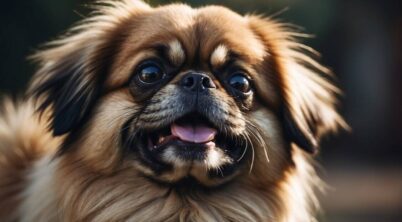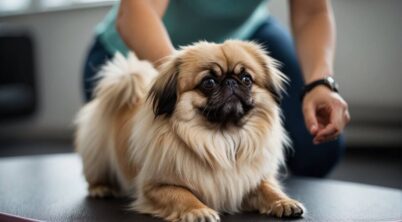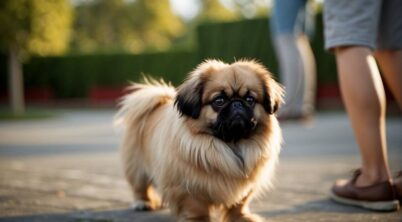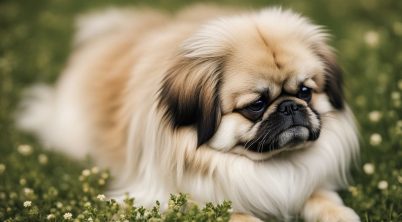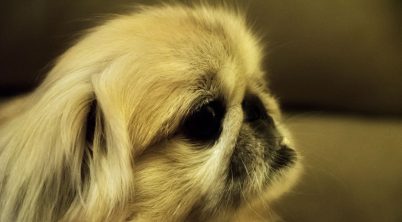Newborn Pekingese puppies epitomize the charm and dignity that this ancient breed is known for. With their lineage tracing back to the imperial courts of China, these toy dogs carry a storied pedigree that is both fascinating and regal. They arrive into the world with a distinctive appearance, characterized by a broad, flat head, deep-set eyes, and a short muzzle that all hint at their noble heritage. As they grow, these traits become more pronounced, revealing the lion-like mane and poised demeanor that Pekingese are celebrated for.
At birth, Pekingese puppies are especially tiny and require careful attention. The first few weeks are critical in ensuring they receive adequate nutrition from their mother and are kept in a warm, safe environment to prevent health issues. As a breed with a flat facial structure, even from a young age they may experience breathing difficulties, which necessitates monitoring and sometimes veterinary intervention to ensure a healthy start to life.
Deploying a carefully structured care and socialization plan during their early development is crucial for these puppies to thrive. Pekingese pups are not just a delight to behold but also possess an independent and sometimes stubborn streak. Positive and gentle training methods introduced from a young age will help shape these affectionate dogs into well-adjusted and sociable family members.
Table of Contents
Newborn Pekingese Dogs
When Pekingese puppies are born, they are notably tiny and delicate creatures, typically weighing just 6 to 8 ounces (170 to 230 grams). These puppies’ birth weight can vary depending on the health, genetics of the parents, and the litter size.
A newborn Pekingese has a distinctive appearance with a flat face, large eyes, and a long, luxuriously soft coat that will continue to grow and become more pronounced as they mature. In their first weeks of life, these puppies require careful attention and must be kept warm, as they are not yet able to regulate their body temperature effectively.
Essential Care:
- Feeding: Newborns nurse every two hours.
- Warmth: They require a steady, warm environment.
- Monitoring: Frequent checks for any signs of distress or health issues.
The Pekingese is a breed with a regal history, once revered as a sacred dog in ancient China. The breed carries a confident and dignified demeanor, which can already be observed during their early days of puppyhood.
Socialization and Training:
- Human Interaction: Gentle handling is important from a young age.
- Socialization: Exposure to mild stimuli for better adaptability.
- Training: Introduction to simple commands and housebreaking can begin once they are a few weeks old.
In summary, newborn Pekingese puppies enchant with their unique appearance and endearing size. As they grow, the nurturing provided during these delicate first weeks is crucial for their development into the dignified and loyal companions the Pekingese are known to be.
History and Origin
The Pekingese, a breed renowned for its lion-like mane and compact stature, originated in Ancient China. Esteemed by the Imperial Family, these dogs were considered semi-divine and akin to the mythic Lion Dog—symbols of protection in Buddhist mythology that were said to resemble lions, believed to be sacred. The presence of such dogs in the Imperial courts underscored their elevated status within Chinese society. Ownership was once restricted to members of the Chinese Royalty, and the breed was deeply intertwined with the legacy of the Buddha.
Imperial Beginnings and Expansion
- Early Records: Originated from imperial courts of China
- Imperial Symbolism: A status symbol among Chinese Royalty
- Cultural Significance: Associated with Buddhist myths and symbolism
During the Second Opium War, the breed cemented its international prominence. In 1860, British and French troops invaded the Beijing Summer Palace, and Pekingese dogs were discovered within. Five Pekingese were taken and gifted to prominent figures in England, one of whom was named “Looty” and presented to Queen Victoria, marking the beginning of the breed’s Western journey.
Spread to the West
- Second Opium War: Pekingese introduced to Europe
- Queen Victoria: “Looty” given to the Queen post-1860 invasion
- Popularity Increase: Began being bred and shown in England
The once imperial-exclusive Pekingese transitioned to popularity among a broader audience, notably the burgeoning middle class of Victorian England, who began breeding and exhibiting these dogs. With this, the Pekingese claimed a new realm in international dog fancy, transcending its origins yet retaining its ancient and noble legacy.
Current Recognition
- Modern Status: Recognized globally as a toy dog breed
- Preserved Characteristics: Continue to exhibit the breed’s storied traits and demeanors
Breed Characteristics
In exploring the world of newborn Pekingese dogs, the breed is distinguished by its ancient royal lineage which is evident in their physical and temperamental traits. These dogs are compact and sturdy with a distinctive lion-like appearance attributed to their history as “Lion Dogs” of Chinese nobility.
Appearance
The Pekingese breed sports a double coat that is long and flowing, contributing to its lion-like demeanor. The coat comes in a variety of colors, including red, gold, sable, white, black and tan, cream, and gray. Their facial structure is characterized by a short snout with large eyes, framed by a V-shaped facial wrinkle.
Personality
As befits their regal and dignified origins, Pekingese puppies exhibit a boldness and independence in their personality. They can be affectionate and loyal to their families, yet maintain an aloofness that speaks to their aristocratic heritage. Despite their cuddly appearance, they are alert and intelligent, but can also show a stubborn streak.
Size and Physique
Pekingese are classified as a toy breed, but they possess a sturdy and stocky build. At maturity, they typically weigh up to 14 pounds. Their height ranges from 6 to 9 inches at the shoulder. Notable is their distinctive rolling gait, a result of a compact, stocky body and slightly bowed limbs.
Behavior and Temperament
When it comes to newborn Pekingese puppies, their behavior and temperament are influenced by their genetics but will continue to be shaped as they grow and develop through interaction and training.
Energy Level
Newborn Pekingese have low to moderate energy levels. Recognized for their serenity, they require less exercise in comparison to more active breeds. As they mature, short play sessions and indoor activities should suffice to meet their exercise needs.
Sociability
Affection Level: Pekingese puppies are affectionate and grow into compassionate lapdogs, enjoying the company of their family members.
- Independent: They demonstrate an independent streak which can be noticeable even from a young age.
- Watchdog Capability: Despite their size, they inherently have a watchdog instinct. This might manifest as alertness to their environment and a readiness to bark at unfamiliar sounds or strangers.
- Playfulness: Puppies will exhibit playfulness in spurts, but typically favor short, manageable bouts of play.
Good With Cats and Other Pets: Pekingese can coexist with cats and other animals if they are socialized early on. Their compatibility with other pets largely depends on individual temperament and socialization.
Family Dog: While their preference for a peaceful environment might make them suited for homes without small, energetic children, with proper socialization and guidance, they can become a cherished part of a family’s life.
Grooming and Care
Pekingese puppies require comprehensive grooming and health care to maintain their well-being. Proper grooming keeps their coat in good condition and reduces the risk of skin issues, while vigilant healthcare can prevent or manage breed-specific ailments.
Coat Maintenance
The Pekingese possesses a double coat, with a thick undercoat and a longer outer coat. Fur maintenance involves:
- Brushing: Daily brushing is mandatory to prevent matting and remove loose hair. An undercoat rake is valuable during shedding seasons.
- Bathing: Bathe your Pekingese every few weeks or as needed, using hypoallergenic dog shampoo to maintain natural oil balance within the fur.
The unique grooming requirements of Pekingese puppies aim to keep their outer coat healthy while minimizing the risks of fold dermatitis, which can occur in skin folds.
Healthcare
Pekingese dogs are prone to several health problems, hence healthcare necessitates:
- Eye Care: Regular cleaning can prevent eye issues, common in Pekingese due to their prominent eyes.
- Disease Screening: Veterinarian visits should include screening for Intervertebral Disc Disease, Brachycephalic Syndrome, and Patellar Luxation.
- Nutrition: Pekingese puppies benefit from a diet with appropriate protein levels to support growth and exercise needs.
Healthcare routines are essential for mitigating the risk of breed-specific health issues and fostering a thriving life for these small canines.
Training and Intelligence
Training newborn Pekingese dogs requires understanding their unique personality traits and intelligence level. They are a breed with a regal history, often showing a courageous and loyal temperament, which influences their learning and training process.
Training Techniques
Newborn Pekingese can benefit from early exposure to training techniques. Due to their sophisticated and sometimes stubborn nature, positive reinforcement is key. This breed responds well to rewards, be it treats or affection, as part of their training regime. Consistency in training sessions will help overcome any obstinate tendencies the Pekingese may exhibit.
- Establish a Routine: Short, consistent training sessions work best.
- Positive Reinforcement: Always reward good behavior to encourage repeated actions.
- Firmness and Patience: Balance firm commands with a patient attitude.
Behavioral Training
Behavioral training for a Pekingese should start early to ensure they develop good habits. Though intelligent, their independent streak might make them less receptive to obedience unless the training interests them. The loyalty of Pekingese can lead to good outcomes when they form a strong bond with their trainer.
- Socialization: Introduce them to various people, pets, and environments.
- Command Training: Focus on basic commands like sit, stay, and come to establish control.
- Curb Biting or Barking: Use firm commands and redirect attention to discourage undesired behavior.
Remember, the intelligence of Pekingese dogs is nuanced, often leaning more towards adaptive intelligence—learning from the environment—rather than pure obedience.
Health Concerns
When considering the acquisition of a newborn Pekingese puppy, potential owners should be aware of specific health concerns that are prevalent within the breed. These include a range of common ailments, particularly due to their brachycephalic nature, and an understanding of their expected lifespan is crucial for providing the best care.
Common Ailments
Brachycephalic Syndrome: Pekingese are classified as a brachycephalic breed due to their short muzzles, which can lead to respiratory issues known as Brachycephalic Syndrome. Symptoms such as snoring, wheezing, and difficulty breathing are common, especially in hot weather or during exercise.
Obesity and Overweight: Newborn Pekingese pups can grow to struggle with weight gain if their calorie intake exceeds their energy expenditure. Causes include overfeeding, insufficient physical activity, and genetic factors. Managing their diet and ensuring adequate exercise is vital for their well-being.
Eye Problems: The prominent eyes of Pekingese dogs are prone to conditions like corneal ulcers and dry eye. Their eye structure increases the risk of injury, making regular checks and care important.
Birth Complications: Often, Pekingese puppies are delivered via C-section due to the breed’s physical conformation. This can correlate with a higher puppy mortality rate and requires attention from breeders and veterinarians.
Life Expectancy
The average lifespan of a Pekingese ranges from 12 to 14 years. While they can enjoy a mostly healthy life, the prevalence of certain inherited conditions should be acknowledged. Regular veterinary check-ups, a suitable diet, and an active lifestyle greatly contribute to maximizing a Pekingese’s life expectancy.
Adoption Information
Adopting a Pekingese puppy is a serious commitment that involves careful consideration of where the puppy is coming from, the conditions of rescue animals, and the environment it will be moving into.
Finding a Breeder
When looking for Pekingese puppies for sale, prospective owners should seek reputable breeders who prioritize the health and well-being of the puppies. A responsible breeder will:
- Provide a clean, nurturing environment
- Show transparency about the health history of the puppies and their parents
- Offer guidance on Pekingese maintenance and care
- Discuss whether a Pekingese is suitable for apartment living based on activity levels and space requirements
Rescue and Adoption
Adopting a Pekingese can be a fulfilling alternative to buying from a breeder. Rescue organizations, such as Pekingese Rescue Network Inc., often house Pekingese dogs in need of a permanent home. Adoption fees typically around $300 contribute to:
- Veterinary care
- Sheltering costs prior to adoption
It’s important that adopters are patient and committed, as rescued Pekingese might require extra care to adjust to a new home due to past neglect or trauma.
Preparing for Home
Once a family has decided on either purchasing from a breeder or adopting, preparing the home is essential. Pekingese puppies require:
- A safe, comfortable space to rest
- Appropriate food that caters to their dietary needs
- Regular grooming to maintain their long coat
- Consideration for their health needs, including vaccinations and preventive treatments
Prospective owners should assess their readiness for a pet that may have considerable maintenance needs.
Cultural Impact
The Pekingese breed has left an indelible footprint on both history and popular culture, reflecting its storied past from the courts of ancient China to modern day representation.
Pekingese in Pop Culture
The Pekingese dog has garnered a notable presence in pop culture, appearing in various forms of media, and often symbolizing luxury and sophistication. Films and television occasionally feature these regal dogs in roles that highlight their elegant and sometimes comedic nature. Their unique appearance and distinct personalities make them memorable characters in the entertainment world. For example, the breed’s survival during the Sinking of the Titanic has been noted in stories, where one such dog named Sun Yat-sen was reportedly saved.
Historical Significance
Historically, the Pekingese was the companion of the ruling classes in Ancient China, specifically within the region that would become Beijing. They were so revered that stealing one was once punishable by death, emphasizing the breed’s significance to the Chinese nobility. Known as “sleeve dogs,” because they were small enough to be carried in the voluminous sleeves of their owner’s robes, they symbolized undying loyalty. The breed was introduced to the Western world when British troops brought them to England from the Summer Palace during the Second Opium War. Their arrival in the West and subsequent recognition by organizations like the American Kennel Club further cemented their status as sophisticated dogs with a regal legacy.



